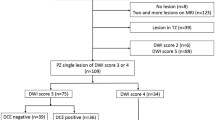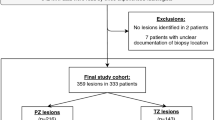Abstract
Purpose
To compare the clinically significant prostate cancer (csPCa) detection rate between diffusion-weighted imaging (DWI) 4 and DWI 3 with positive dynamic contrast-enhanced (DCE) (hereinafter called ‘DWI 3/DCE+’) lesions in the peripheral zone (PZ) and to explore the diagnostic performance of targeted biopsy (TB) or systematic biopsy (SB) in patients with Prostate Imaging Reporting and Data System (PI-RADS) 4 lesions.
Methods
We retrospectively enrolled 206 patients who underwent multiparametric magnetic resonance imaging and had at least one PI-RADS 4 lesion in the PZ. All patients subsequently underwent combined magnetic resonance imaging/ultrasound fusion-guided TB and ultrasound-guided 12-core SB. The chi-square test was used to compare the csPCa detection rates between DWI 4 and DWI 3/DCE+ lesions. Based on the TB + SB results as a standard reference, we analyzed the sensitivity, negative predictive value, and diagnostic accuracy of TB alone or SB alone.
Results
Patients with DWI 4 lesions had higher csPCa detection rate than those with DWI 3/DCE+ lesions when using TB + SB, TB, and SB, and the differences were significant for TB + SB (72.22 vs. 54.84%, p = 0.015) or SB (65.97 vs. 46.77%, p = 0.010). For DWI 3/DCE+ patients whose prostate-specific antigen levels ranged from 4 to 10 ng/mL, TB alone showed the highest negative predictive value (95% Cl 78.12–100).
Conclusions
DWI 4 tends to have worse results than DWI 3/DCE+. TB has great diagnostic performances in DWI 3/DCE+ patients, especially for those prostate-specific antigen ranging from 4 to 10 ng/mL.
Graphical abstract




Similar content being viewed by others
References
Drost FH, Osses D, Nieboer D, et al. Prostate Magnetic Resonance Imaging, with or Without Magnetic Resonance Imaging-targeted Biopsy, and Systematic Biopsy for Detecting Prostate Cancer: A Cochrane Systematic Review and Meta-analysis. Eur Urol 2020;77(1):78-94.
Weinreb JC, Barentsz JO, Choyke PL, et al. PI-RADS Prostate Imaging - Reporting and Data System: 2015, Version 2. Eur Urol 2016;69(1):16-40.
Turkbey B, Rosenkrantz AB, Haider MA, et al. Prostate Imaging Reporting and Data System Version 2.1: 2019 Update of Prostate Imaging Reporting and Data System Version 2. Eur Urol 2019;76(3):340–351.
Woo S, Suh CH, Kim SY, Cho JY, Kim SH. Diagnostic Performance of Prostate Imaging Reporting and Data System Version 2 for Detection of Prostate Cancer: A Systematic Review and Diagnostic Meta-analysis. Eur Urol 2017;72(2):177-188.
Ullrich T, Quentin M, Arsov C, et al. Value of Dynamic Contrast-Enhanced (DCE) MR Imaging in Peripheral Lesions in PI-RADS-4 Patients. Rofo 2020;192(5):441-447.
Wang B, Gao J, Zhang Q, et al. Investigating the equivalent performance of biparametric compared to multiparametric MRI in detection of clinically significant prostate cancer. Abdom Radiol (NY) 2020;45(2):547-555.
European Association of Urology. EAU-EANM-ESUR-ESTRO-SIOG Guidelines on Prostate Cancer; 2020, Available at: https://uroweb.org/guideline/prostate-cancer/. Accessed October 1, 2021
Patel HD, Koehne EL, Shea SM, et al. Systematic versus Targeted MRI/Ultrasound Fusion Prostate Biopsy Among Men with MRI-Visible Lesions. J Urol 2021:101097ju0000000000002120.
Ahdoot M, Wilbur AR, Reese SE, et al. MRI-Targeted, Systematic, and Combined Biopsy for Prostate Cancer Diagnosis. N Engl J Med 2020;382(10):917-928.
Chen Y, Ruan M, Zhou B, et al. Cutoff Values of Prostate Imaging Reporting and Data System Version 2.1 Score in Men With Prostate-specific Antigen Level 4 to 10 ng/mL: Importance of Lesion Location. Clin Genitourin Cancer 2021;19(4):288–295.
Engels RRM, Israël B, Padhani AR, Barentsz JO. Multiparametric Magnetic Resonance Imaging for the Detection of Clinically Significant Prostate Cancer: What Urologists Need to Know. Part 1: Acquisition. Eur Urol 2020;77(4):457–468.
Epstein JI, Egevad L, Amin MB, Delahunt B, Srigley JR, Humphrey PA. The 2014 International Society of Urological Pathology (ISUP) Consensus Conference on Gleason Grading of Prostatic Carcinoma: Definition of Grading Patterns and Proposal for a New Grading System. Am J Surg Pathol 2016;40(2):244–252.
Epstein JI, Walsh PC, Carmichael M, Brendler CB. Pathologic and clinical findings to predict tumor extent of nonpalpable (stage T1c) prostate cancer. Jama 1994;271(5):368-374.
Mazzone E, Stabile A, Pellegrino F, et al. Positive Predictive Value of Prostate Imaging Reporting and Data System Version 2 for the Detection of Clinically Significant Prostate Cancer: A Systematic Review and Meta-analysis. Eur Urol Oncol 2020.
Stabile A, Giganti F, Rosenkrantz AB, et al. Multiparametric MRI for prostate cancer diagnosis: current status and future directions. Nat Rev Urol 2020;17(1):41-61.
Venderink W, van Luijtelaar A, Bomers JGR, et al. Results of Targeted Biopsy in Men with Magnetic Resonance Imaging Lesions Classified Equivocal, Likely or Highly Likely to Be Clinically Significant Prostate Cancer. Eur Urol 2018;73(3):353-360.
Stabile A, Barletta F, Motterle G, Pellegrino F, Sorce G, Mazzone E, et al. Optimizing prostate-targeted biopsy schemes in men with multiple mpMRI visible lesions: should we target all suspicious areas? Results of a two institution series. Prostate Cancer Prostatic Dis 2021;24(4):1137-42.
Cristel G, Esposito A, Damascelli A, et al. Can DCE-MRI reduce the number of PI-RADS v.2 false positive findings? Role of quantitative pharmacokinetic parameters in prostate lesions characterization. Eur J Radiol 2019;118:51-57.
Tamada T, Kido A, Yamamoto A, et al. Comparison of Biparametric and Multiparametric MRI for Clinically Significant Prostate Cancer Detection With PI-RADS Version 2.1. J Magn Reson Imaging 2021;53(1):283–291.
Bass EJ, Pantovic A, Connor M, et al. A Systematic Review and Meta-analysis of the Diagnostic Accuracy of Biparametric Prostate MRI for Prostate Cancer in Men at Risk. Prostate Cancer Prostatic Dis 2020.
Kasivisvanathan V, Rannikko AS, Borghi M, Panebianco V, Mynderse LA, Vaarala MH, et al. MRI-Targeted or Standard Biopsy for Prostate-Cancer Diagnosis. N Engl J Med 2018;378(19):1767-77.
Aminsharifi A, Howard L, Wu Y, et al. Prostate Specific Antigen Density as a Predictor of Clinically Significant Prostate Cancer When the Prostate Specific Antigen is in the Diagnostic Gray Zone: Defining the Optimum Cutoff Point Stratified by Race and Body Mass Index. J Urol 2018;200(4):758-766.
Kasivisvanathan V, Stabile A, Neves JB, et al. Magnetic Resonance Imaging-targeted Biopsy Versus Systematic Biopsy in the Detection of Prostate Cancer: A Systematic Review and Meta-analysis. Eur Urol 2019;76(3):284-303.
Elwenspoek MMC, Sheppard AL, McInnes MDF, et al. Comparison of Multiparametric Magnetic Resonance Imaging and Targeted Biopsy With Systematic Biopsy Alone for the Diagnosis of Prostate Cancer: A Systematic Review and Meta-analysis. JAMA Netw Open 2019;2(8):e198427.
Ahmed HU, El-Shater Bosaily A, Brown LC, et al. Diagnostic accuracy of multi-parametric MRI and TRUS biopsy in prostate cancer (PROMIS): a paired validating confirmatory study. Lancet 2017;389(10071):815-822.
Schoots IG, Roobol MJ, Nieboer D, Bangma CH, Steyerberg EW, Hunink MG. Magnetic resonance imaging-targeted biopsy may enhance the diagnostic accuracy of significant prostate cancer detection compared to standard transrectal ultrasound-guided biopsy: a systematic review and meta-analysis. Eur Urol 2015;68(3):438-450.
Funding
This work was supported by the National Key Research and Development Program of China (Grant Nos. 2021YFC2009300 and 2021YFC2009301).
Author information
Authors and Affiliations
Contributions
All authors contributed to the study conception and design. Material preparation, data collection and analysis were performed by Zhoujie Sun, He Wang, Weixiao Fu, Sainan Zhu and Gang Song. The first draft of the manuscript was written by Zhoujie Sun and all authors commented on previous versions of the manuscript. All authors read and approved the final manuscript. Conceptualization: Gang Song, Zhoujie Sun; Methodology: Gang Song, Zhoujie Sun; Formal analysis and investigation: He Wang, Weixiao Fu, Sainan Zhu; Writing—original draft preparation: Zhoujie Sun; Writing—review and editing: Gang Song, He Wang; Funding acquisition: Gang Song; Resources: Gang Song, He Wang; Supervision: Gang Song.
Corresponding author
Ethics declarations
Conflict of interest
The authors declare that they have no conflict of interest.
Ethics approval
The study was performed in accordance with the ethical standards as laid down in the 1964 Declaration of Helsinki and its later amendments or comparable ethical standards, and approved by the Ethics Committee of Peking University First Hospital (protocol code 2016-1275).
Informed consent
Informed consent was obtained from all subjects involved in the study.
Additional information
Publisher's Note
Springer Nature remains neutral with regard to jurisdictional claims in published maps and institutional affiliations.
Rights and permissions
Springer Nature or its licensor (e.g. a society or other partner) holds exclusive rights to this article under a publishing agreement with the author(s) or other rightsholder(s); author self-archiving of the accepted manuscript version of this article is solely governed by the terms of such publishing agreement and applicable law.
About this article
Cite this article
Sun, Z., Wang, H., Fu, W. et al. MRI-based analysis of different clinically significant prostate cancer detection rate of prostate imaging reporting and data system score 4 in the peripheral zone. Abdom Radiol 48, 390–398 (2023). https://doi.org/10.1007/s00261-022-03712-0
Received:
Revised:
Accepted:
Published:
Issue Date:
DOI: https://doi.org/10.1007/s00261-022-03712-0




